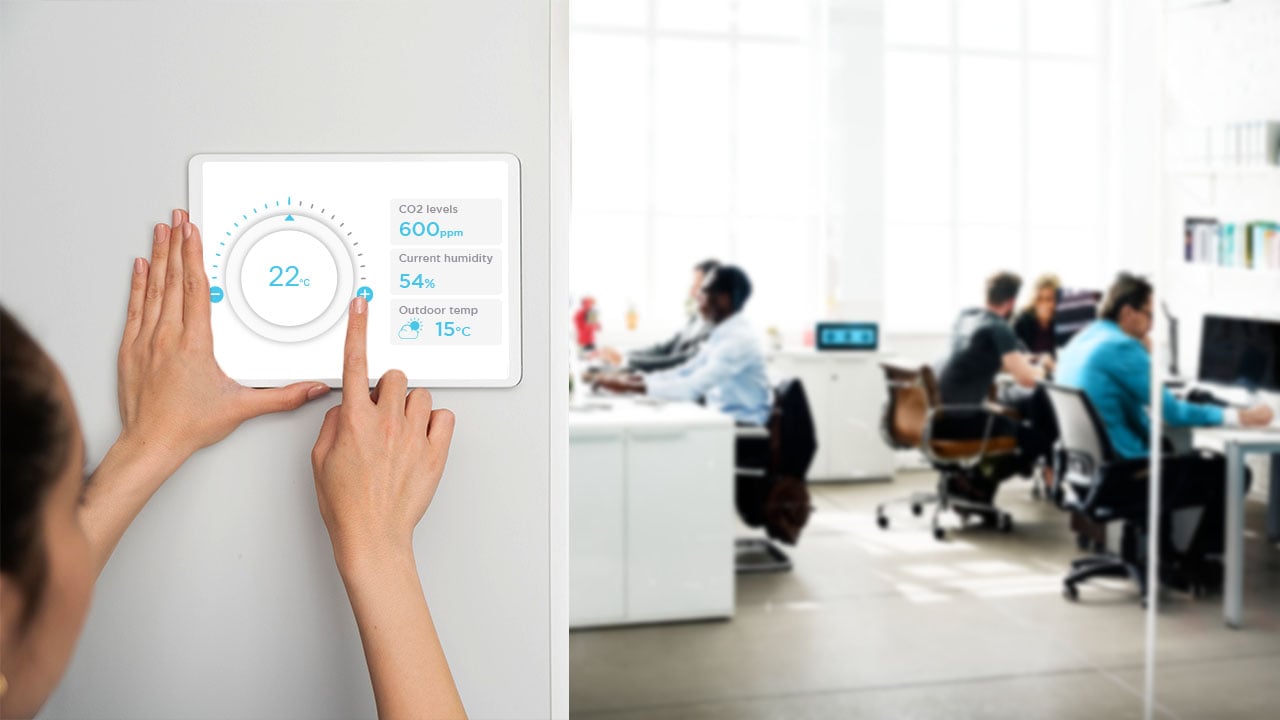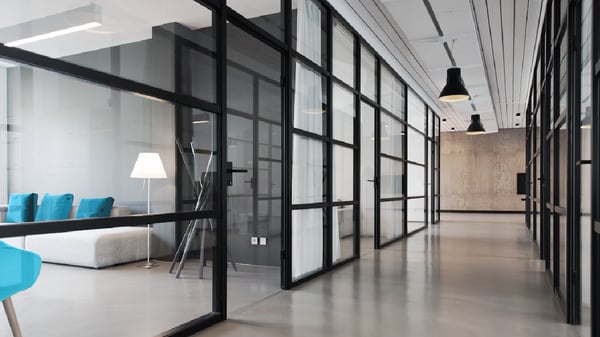Every company and organization wish for skilled and loyal employees, not only by the tasks they fullfill but good communication, engagement and initiatives are often what differs a market leader from their competitors. Therefore positive working conditions is a priority when a company is looking for a new location. A healthy indoor climate is one with fresh air, moderate temperature, good acoustics and without harmful radiations. Not only does it help create a safe living environment, it also enables people to be happier and more productive.
At the heart of every healthy indoor climate is an efficient ventilation system. By pumping in fresh air, and evacuating used air, as per changes in occupancy, humidity, temperature, and radon levels etc., a ventilation system keeps a building’s atmosphere stabile.
In the following article, we will explain the different factors affecting indoor climate, and how you can keep your air quality optimized, according to global standards.
Main Factors Affecting Indoor Climate
The most important factors that directly impact a building’s environment and indoor climate:
- Thermal: Air and radiant temperature, humidity, air velocity etc.
- Atmospheric: Indoor air quality, gases, moisture, odours, microbes, and dust particles etc.
- Acoustic: Noise, vibrations, sound transmission etc.
- Mechanical: The effects of the building’s interior (furniture, walls, paint etc.) to its users, ergonomics etc.
- Radioactive: Radon and other radiations emitted by building materials.
Why Considering the Indoor Climate?
Here are some of the reasons why your building should have an optimized indoor climate:
1. Comfort
One of the primary benefits of a healthy indoor climate is the comfort it provides. We have all experienced to pause a productive meeting or workshop in order to open windows and ventilate the room.
Moreover, a welcoming interior, coupled with good acoustics is related to a comfortable working environment.
2. Health and Well-being
We spend over 90% of our time indoors, this is why indoor climates have a direct relation with the health of their occupants.
A healthy climate, full of fresh air, and devoid of pollutants and microbes, promotes well-being and good health. A bad indoor climate can have several harmful effects on human bodies, including respiratory and heart diseases.
3. Attract More Tenants and Visitors
We seek pleasant environments, and shopping will soon end if we experience bad air, wrong temperature og unpleasant noise. If the workplace is physically unpleasant more time is spend on home office or the workday may be shorter, which effects both communication, work environment and productivity.
4. Increased Efficiency
Building automation solutions are used for healthy indoor climates, also ensure increased efficiency, and decreased maintenance costs. The system adjusts itself based on atmospheric changes. Good monitoring will show errors before tenants experience the consequences.
Most Important Elements of an Indoor Climate
There are many elements that govern just how good or bad your indoor climate is. The most important ones are as follows:
1. Air Temperature
What is the temperature of the air being felt by a person within a building? Air temperature is arguably the most important element of an indoor climate.
2. Air Velocity
How fast is the air as it touches a person? Faster air allows for a greater exchange of heat between the air and the person.
3. Airborne contaminants
These usually include the gases and particles emitted from equipment, carpets, furniture, and other building materials, along with pollutants and microbes.
4. Sound absorption and reverberation time
Reverberation time is the time it takes for a sound to completely fade away in a space. This is a measure of loss of sound energy when sound waves collide with absorbent materials like walls, ceilings, and floors etc. Sound absorption techniques can be used to decrease reverberation times.
5. Ventilation
Efficient ventilation is a staple of buildings with excellent indoor climate. Not only does it moderate temperature, but also decreases moisture, humidity, odours, and microbes present in the inner atmosphere. At the same time ventilation is the reason of high energy use and the right ventilation will avoid over use of engergy.
6. Indoor Air Quality
Indoor air quality determines both the short-term and long-term well-being of your occupants. Though the experience of wellbeing and comfort of your occupants may differ from person to person and as a landlord measurering of the air quality and tempeture will be beneficial. ClevAir is a software that together with sensors measures the air quality and based on this optimize the ventilation in order to only use energy when and where it is needed. The solution results in a lower use of energy, lower the CO2-emission and stabalize the inndoor climate with an dahsboard overview.

Standards for Indoor Climate
Following is a non-exhaustive list of indoor climate standards that you should strive to conform with:
- Indoor humidity standards: ASHRAE recommends maintaining relative humidity at or below 65%.
- Indoor temperature standards: According to research, the ideal indoor temperatures are between 70 – 72 °F (21-22 °C). It’s perfect for boosting productivity.
The Environment Act for indoor climate by Arbeidstilsynet, recommends maintaining a temperature of 19-26 °C for light work, 16-26 °C for medium work, and 10-26 °C for heavy work.
- Indoor CO2 standards: For good indoor air quality, ASHRAE recommends the CO2 concentrations to be at or below 1000 ppm in schools, and 800 ppm in offices.
- Indoor air velocity standards: ISO 7730 mentions maximum mean air velocity of 0.12 m/s in summers, and 0.1 m/s in winters.
- Radon level standards: Radon levels of greater than 4 pCi/L (picocuries per litre) warrant immediate fixes in the property. With that said, there is still no unanimously agreed-upon safe level of Radon exposure.
- Indoor Air quality standards: EPA has set different air quality standards, depending on the pollutant in question. E.g., 9ppm of Carbon monoxide, over an averaging time of 8 hours, shouldn’t be exceeded more than once/per year.
Norwegian air quality standards by Arbeidstilsynet, are mentioned in this document.

How to Improve Indoor Climate
The journey to optimizing your indoor air quality has the following broad steps:
- Identify where you stand.
By installing sensors you gather data, and can compare with some of the standardized values shared in the previous section. ClevAir has choosen to use sensors from AirThings.
- Improve where necessary.
With correct data you will find avenues for improvement. In order to avoid over consumption you should optimize the indoor climate via demand-controlled ventilation (DCV). DCV adjust your ventilation based on real-time changes in factors like occupancy, temperature, CO2 levels, and outdoor weather.
The best part about DCV is that you don’t even have to invest in a whole new system. ClevAir can integrate with your existing HVAC/ventilation system no matter of BMS system or not. With correct ventilation you do not only improve the air quality, you also reduse the energy use by 15 – 25 %. Ventilation is run on full throttle in peak hours, and at minimum speed during of-peak hours.
Read more: How building automation works with ClevAir
Final word
Good indoor climate is crucial for your health, safety, and comfort of your tenants. It also has an impact on your building’s market valuation, and enables you to form a competitive advantage. By automating your building’s ventilation system, not only can you revitalize your indoor climate, but also significantly reduce energy usage, since HVACs consume more energy than any other building system.





Comments
Add Comment